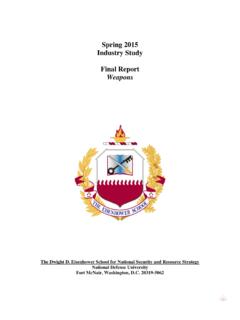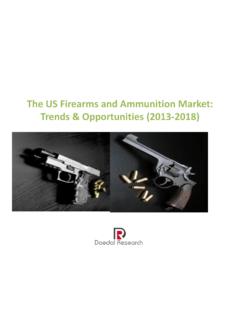Transcription of Reconsidering local competition: Organizational relocation ...
1 Reconsidering local competition : Organizational relocation and geographic concentration in the US firearms industry , 1790-1914 Chirag Kasbekar Goizueta Business School, Emory University, Atlanta, GA, USA Email: Page 1 of 32 ANZAM 2012 Reconsidering local competition : Organizational relocation and geographic concentration in the US firearms industry , 1790-1914 Abstract: The negative effects of location in dense areas on the survival of organizations have been almost entirely attributed to the local nature of competition . To examine the salience of this theory, I choose an industrial setting in which organizations located in concentrated areas face higher mortality the US firearms industry and set up a test for the theory based on the impact of geographic concentration on an alternative indicator: Organizational relocation .
2 Results indicate that organizations are more likely to relocate from dense areas to other dense areas and thus local competition is unlikely to be the main mechanism driving relocation . I present conjectures that provide alternative explanations for the observed effect of geographic concentration on both relocation and exit rates. Keywords: competitive environment, competitive dynamics, industry analysis, competitive advantage Almost all industries are geographically concentrated to a certain degree (Glen Ellison and Glaeser 1997; Ciccone 2002; Rosenthal and Strange 2004). Research on the impact of geographic concentration on organizations, however, has presented a mixed picture.
3 In dense areas organizations can benefit from localized externalities such as knowledge spillovers but also face the potential hazards of crowding or greater local competition . There is a considerable body of evidence confirming the existence of localized positive externalities that offer advantages to co-located firms (Rosenthal and Strange 2004). In some industries this allows organizations located in dense areas to benefit overall in comparison with other organizations. On the other hand, in some industries hazardous local forces appear to dominate and organizations in dense areas are more likely to die than other organizations (Sorenson and Audia 2000).
4 The positive effects of location in dense areas on the performance and survival of organizations have been attributed to a number of forces, including the sharing of inputs (Diamond and Simon 1990; Marshall 1920) and knowledge spillovers across co-located organizations (Almeida and Kogut 1999; Jaffe, Trajtenberg, and Henderson 1993; Krugman 1991; Marshall 1920). The negative effects, on the other hand, have been almost entirely attributed, in both the economic (Th nen 1966; Alonso 1964; Hotelling 1929; Krugman 1980; Davis and Weinstein 1998) and sociological literatures (Carroll and Wade 1991; Page 2 of 32 ANZAM 2012 Hannan and Carroll 1992; Swaminathan and Wiedenmayer 1991; Baum and Singh 1994; Hannan et al.)
5 1995), to the localized nature of competition . While there are plausible reasons to believe that geographical limits to competition do exist there are also reasons to believe that empirical studies have overestimated the degree to which competition is geographically localized by ignoring alternative explanations. This study aims to examine this possibility. More specifically, since most studies that have claimed evidence for localized competition have relied on the Organizational mortality hazard as an indicator of competition , I will ask if studies of the local nature of competition that are based on estimates of Organizational mortality hazards need to account for alternative explanations for Organizational exit that have been so far been ignored.
6 For example, it is plausible that organizations exit more in dense areas because entrepreneurs and decision makers in these organizations have more alternative opportunities in terms of employment in other organizations than do entrepreneurs in sparser areas. To investigate the extent to which Organizational mortality might overestimate the importance of local competition , I will examine the impact of geographic concentration on an alternative indicator of local competition Organizational relocation in a setting where organizations in concentrated areas face higher hazards of exit. Organizational relocation allows me to study not only organizations leaving a particular location but also where they choose to locate after they exit.
7 As I discuss below, this provides a simple but clear way to investigate whether local competition or another process is driving organizations out of their location. I study relocation in the US firearms industry from 1790 to 1914. This is an appropriate setting for two reasons. First, this is an industry that experienced higher exit rates in dense areas and therefore hazardous localized competition is a good candidate explanation for Organizational outcomes. Second, in the US firearms industry during this time period roughly seven percent of all firms relocated at least once in their life history, which is a significant proportion of firms.
8 Page 3 of 32 ANZAM 2012 Localized competition as a source of dispersion and spatial sorting: economic geography Localized competition has been seen in the economic geography literature as a source of geographic dispersion. As the number of organizations located in an area rises, competition for local resources increases and organizations face not only lower revenues (as the customer or client base has to be shared by more organizations) but also higher costs (as the prices of scarce inputs increase). Due to the lower profitability, organizations and entrepreneurs feel pressured to either exit the industry all together or locate in peripheral areas where there is less competition (Combes, Mayer, and Thisse 2010).
9 Not only do entrepreneurs that want to avoid competition tend to found their new organizations in sparser areas but also incumbent organizations escaping competition choose to relocate to such areas (Baldwin and Okubo 2005). There exists the possibility of self-selection (Baldwin and Okubo 2005) that leads to geographic sorting of organizations. Heterogeneity among organizations in terms of productivity would cause differences in the degree to which they are able to deal with the potential consequences of local competition . Highly efficient and productive organizations have lower marginal costs, which makes the localized external economies possible in concentrated areas more attractive to them than it does to less efficient organizations.
10 Their higher productivity also makes them better able to tide over the effects of competition . Thus they would be more likely to relocate from sparse areas to dense areas than the other way around. The opposite would be the case with relatively inefficient organizations. Given different types of balance or imbalance between these two opposing movements, a strong role for localized competition in these theories would be consistent with the following overall relocation patterns: 1) organizations are more likely to relocate from concentrated areas to sparse areas, 2) organizations are more likely to relocate from sparse areas to concentrated areas, 3) there is no significant pattern movements in both directions balance each other out, 4) there is a non-linear effect of geographic concentration on relocation as numbers of organizations increase in an area, either of two possibilities occurs.









